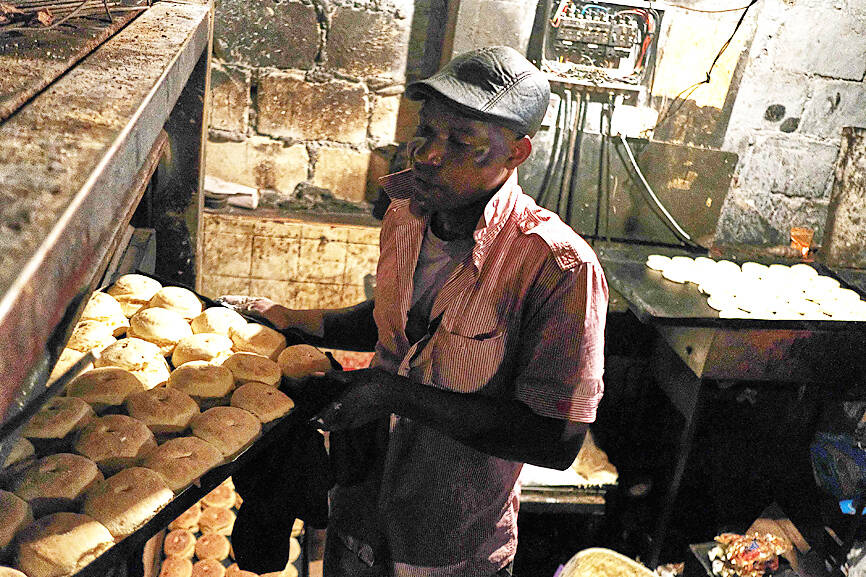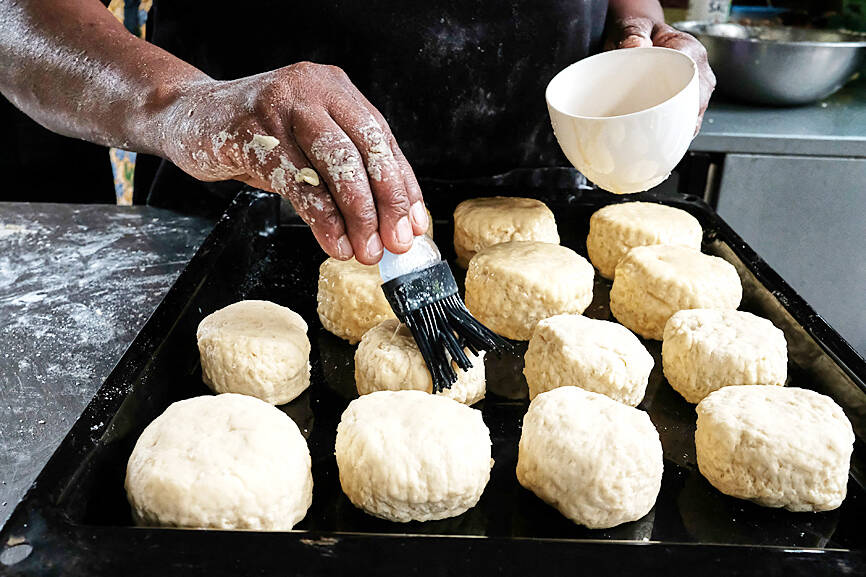A sweet doughy treat from Britain has become a beloved part of Zimbabwe’s national cuisine, where despite the country’s colonial past, mothers and chefs alike claim the pastry as their own.
The scone, which Brits normally enjoy with afternoon tea, is ubiquitous in Harare, the southern African country’s capital. A breakfast favorite in these parts, it can be found everywhere from high-end eateries to the market stalls of impoverished townships.
“We love scones. They are not British, they are ours, our local scones,” rights activist Nyari Mashayamombe said, as she left an upmarket restaurant in Harare’s Belgravia district, its garden dotted with open umbrellas.

Photo: AFP
Dense yet airy, Zimbabwean scones are the result of the intercultural mix that came with colonization, said Mashayamombe, a red-haired 42-year-old who is also a singer and media personality.
In “fancy places like here... a beautiful scone goes as high as six bucks,” she said, referring to the US dollars that have become Zimbabwe’s parallel and preferred currency. “It’s worth it.”
A few kilometers away at a market in Harare’s oldest township of Mbare, scones are impossible to find after midday.

Photo: AFP
“We sold them all this morning. They move quickly,” one vendor said
The main communal bakery in Mbare, a bustling working-class district, opens at dawn.
Tawanda Mutyakureva, 26, arrives at about 5am to his work station, measuring 2m2, where he has to bend over to spread the dough on a knee-height countertop.
Every day he cranks out about 200 scones in an overheated room with cinder-block walls, lit by two bulbs hanging from a wire. Brandishing a cookie cutter, he works quickly to whip out one batch after another, with each scone selling for US$0.25.
In the hot, humid atmosphere redolent of yeast, his wife — with their baby strapped to her back — helps him with buttering the pastries and clearing plates. Resellers come in to buy 10 or 20 pieces to be sold at small grocery stores.
Memory Mutero, 46, was at the bakery to buy bread, as she makes her own scones at home.
“I make scones for my three kids. It takes about 45 minutes,” she said.
Her ingredients are simple: flour, salt, yeast, sugar, butter and milk.
At the Bottom Drawer, an upscale tearoom in Harare, cook Veronica Makonese is unimpressed after tasting a scone brought back from the township.
“There is no milk in those, they used water,” the 46-year-old cook said.
A white kerchief on her head, Makonese said she makes her own buttermilk for her scones, to control temperature and acidity levels, and uses only real butter to ensure the proper taste and softness.
Her boss, Sarah Macmillan, a 53-year-old Zimbabwean, said she longs for the scones she would eat as a child.
Back then, two shops in the center of Harare, now closed, competed for the crown of best scone in the country, and Macmillan wanted her tearoom to make some that are “just as good.”
The secret of the little cake’s enduring success, in a country struggling with endemic poverty, is simple, Macmillan said.
“It’s very filling and affordable,” she said.

The US dollar was trading at NT$29.7 at 10am today on the Taipei Foreign Exchange, as the New Taiwan dollar gained NT$1.364 from the previous close last week. The NT dollar continued to rise today, after surging 3.07 percent on Friday. After opening at NT$30.91, the NT dollar gained more than NT$1 in just 15 minutes, briefly passing the NT$30 mark. Before the US Department of the Treasury's semi-annual currency report came out, expectations that the NT dollar would keep rising were already building. The NT dollar on Friday closed at NT$31.064, up by NT$0.953 — a 3.07 percent single-day gain. Today,

‘SHORT TERM’: The local currency would likely remain strong in the near term, driven by anticipated US trade pressure, capital inflows and expectations of a US Fed rate cut The US dollar is expected to fall below NT$30 in the near term, as traders anticipate increased pressure from Washington for Taiwan to allow the New Taiwan dollar to appreciate, Cathay United Bank (國泰世華銀行) chief economist Lin Chi-chao (林啟超) said. Following a sharp drop in the greenback against the NT dollar on Friday, Lin told the Central News Agency that the local currency is likely to remain strong in the short term, driven in part by market psychology surrounding anticipated US policy pressure. On Friday, the US dollar fell NT$0.953, or 3.07 percent, closing at NT$31.064 — its lowest level since Jan.

Hong Kong authorities ramped up sales of the local dollar as the greenback’s slide threatened the foreign-exchange peg. The Hong Kong Monetary Authority (HKMA) sold a record HK$60.5 billion (US$7.8 billion) of the city’s currency, according to an alert sent on its Bloomberg page yesterday in Asia, after it tested the upper end of its trading band. That added to the HK$56.1 billion of sales versus the greenback since Friday. The rapid intervention signals efforts from the city’s authorities to limit the local currency’s moves within its HK$7.75 to HK$7.85 per US dollar trading band. Heavy sales of the local dollar by

The Financial Supervisory Commission (FSC) yesterday met with some of the nation’s largest insurance companies as a skyrocketing New Taiwan dollar piles pressure on their hundreds of billions of dollars in US bond investments. The commission has asked some life insurance firms, among the biggest Asian holders of US debt, to discuss how the rapidly strengthening NT dollar has impacted their operations, people familiar with the matter said. The meeting took place as the NT dollar jumped as much as 5 percent yesterday, its biggest intraday gain in more than three decades. The local currency surged as exporters rushed to